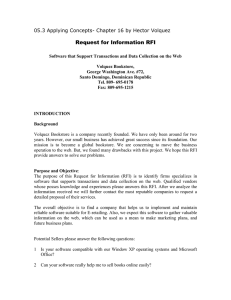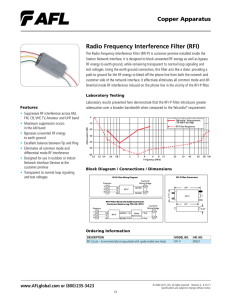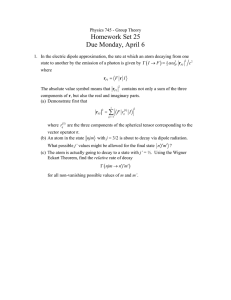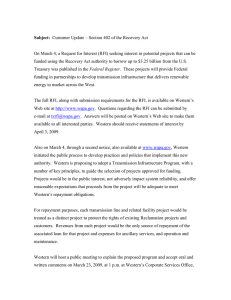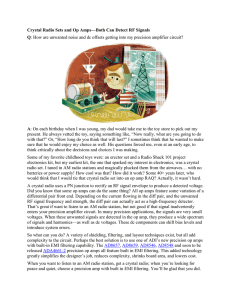Radio Frequency Interference (RFI)
advertisement
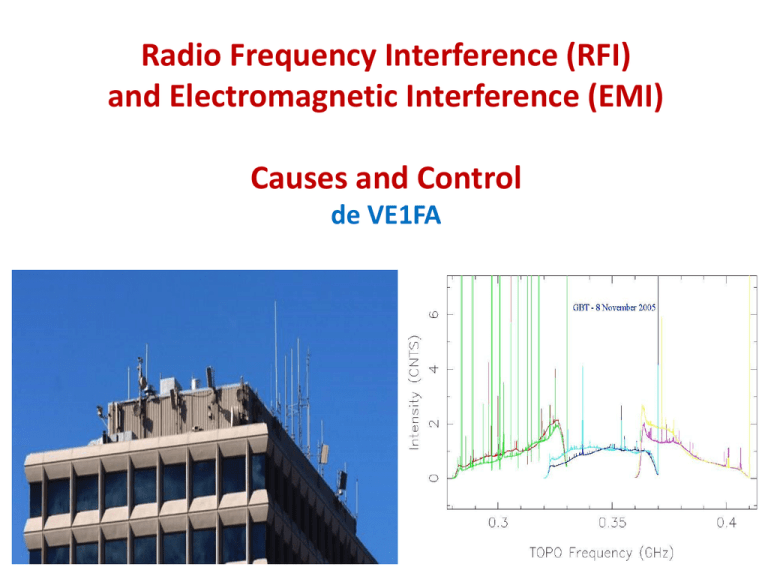
Radio Frequency Interference (RFI) and Electromagnetic Interference (EMI) Causes and Control de VE1FA Industry Canada says: • • 8. Interference “Transmissions from an amateur station shall not cause harmful interference to a station operating in another service nor be protected from interference caused by a RFI/EMI seen in spectrum scan at Jodrell Bank Radiotelescope, UK Spectral Scan By Low Frequency Astronomical Radio (LOFAR) receiver in Europe Main noise paths into your Rx: conducted and received Electromagnetic inteference (EMI) => produced in nonradio electronics + electrics Radio Frequency Interference (RFI) => produced in radio/TV EMI/RFI Susceptibility: varies greatly with design of affected device US FCC: part 15 regs: EMI/RFI susceptibility/emission standards for all electronics sold I-C: asleep at the wheel for years: no standards (until March 12, 2009??) -Therefore manufacturers have used Canada as dumping • • • • • • Common domestic noise (RFI/EMI) sources (worst at lower MF/HF frequencies) Power lines, their hardware (hum, arc, spark, corona buzz, HV buzz) AC light dimmers Computers + all microprocessors with digital clock (oscillator) Brush-type motors (vacuum, sewing machine, power tools) Thermostats, power controllers, motor controllers (washer, dryer, fridge, etc.) Common AC + DC brush-type motors: always produce sparks and EMI! Series L, shunt C can suppress EMI from sparking brushes The rusty bolt effect Junctions between different corroded metals can act as diodes. When two or more strong RF signals “received” by metal structure or objects MIXING can occur. Result: many mixer sums/differences => => more mixing => => lots of spurious signals!! Common in : old plumbing, rain gutters, rusty masts, rusty towers, especially when ferrous metals were originally galvanized. Minimizing RFI emissions from your station • • • Ensure Tx working properly, good signal reports (voice quality/distortion, key clicks on CW). Properly adjust: mic gain; compression/processing; SWR; power out. All Tx-linked equipment should be properly grounded! (HF most important). • Good shielding on Tx/Rx signal path in station. • AC line filters. Station (RF) Grounding • Very important at MF/HF to have a good RF ground. • Minimizes RFI in/out, optimizes Tx+Rx efficiency. • Makes grounded electronics cases and coax shields into effective RFI/EMI shields. • All boxes grounded to a common buss: NOT a daisy chain! • Ground lead should be <1/4λ. • Heavy wire or braid to heavy copper stake (iron/steel not good). • Multiple ground stakes connected with heavy wire best. • Water pipe ground…often no good. • Copper water pipe: makes good buss, makes good ground Intermodulation (intermod): mixing of strong undesired signals in RF amp/Mixer of receiver, resulting in spurious mixer products, splatter, and desense. Frequency filters: can solve many EMI + RFI problems :effective at both noise source and at transceiver : most effective when used at both FILTER TYPES: High-pass Low-pass Band-pass Band reject Notch/Peak Finding and fixing RFI/EMI sources at home and locally • Listen on radio: disconnect appliances/circuits one at a time • Is noisy device defective? • Try AC power line filter on noisy appliance. • • • • Try chokes, capacitive bypasses on long leads from noise source. Check ground of source (if appropriate) NS Power grid/pole: locate noise source, phone company with details Noise from neighbor’s house/posessions… Diplomacy comes first! • Modifying or repairing neighbors’ electronics is risky! • Big antenna = interference with neighbors’ stuff! Typical ham transmitter interference with TV/VCR Tx QRM (Basic problem is oftenNormal poor TV/VCR design) TV filters AC line choke/filter Well-designed isolation transformer: removes EMI/RFI and “common mode” noise High current applications => large heavy expensive transformer Shielded, minimal capacitance TVI: how to infuriate your neighbors! Low and high-pass filters for received (antenna) interference HF Tx low pass (<40 MHz) TV high pass ( >50 MHz) => Telephone low-pass => 2 meter 100W band-pass filter (DCI) -passive filter for 2m transceivers -greatly decreases intermod in high signal environment -Zin + Zout = 50 Ω -3 = 137 MHz -4 = 154 MHz -1 = 144 MHz -2 = 146 MHz 0 db => 1 2 3 -80db => 4 Ferrite and powdered iron toroids and beads: keep RFI off wires and cables Many “mixes”! Mix #43 good for general RFI Metal Oxide Varistor (MOV): shorts out rapid (microsecond) transients Direct short across device at clamping voltage 8 μsec rise-20 μsec fall times Tolerates short duration spikes only Good for lightning, inductive spikes Ceramic + zinc oxide This one: 385 V “clamping voltage” Lifetime dependent on number and size of spikes absorbed LC Line Filters-The Way to Go! Input protection and RFI/EMI suppression Metal oxide varistors (MOV) Stereo system QRM from amateur Tx Often speaker leads acting as antenna Assume both speaker leads are NOT DC grounded! Shielded wire often best solution. Ferrite inductors with speaker leads wound around them usually help (chokes) Sometimes AC power line filter helps too. “Modern” devices often producing MF-HF interference • • 1. DVD players 2. In-line or “wall-wart”-type laptop power supplies (often switcher- type) • 3. Newer front-loading washing machines • 4. Laptops (some good, some BAD!) • 5. Plasma flat-screen TVs • 6. Automotive engine computers (some) • 7. ADSL box/desktop computer combination • 8. ”Touch” –controlled lights, faucets, etc. • 9. “Coil”-type fluorescent bulbs –some good, some bad • 10. Wireless modem jacks, digital cable converters Miscellaneous • • • • • Operating log: keep one to correlate complaints with operation Harmonics: multiples of carrier, internal frequencies Parasitics: unintended oscillations in a circuit, often at VHF frequencies in HF power amplifiers Stub trap: single frequency notch filter made from λ/4 length of transmission line Rectification: EMI/RFI can produce DC in affected circuits, altering their performance Radio-frequency Interference (RFI) END
